———————————————————————
From the Northern Crew:
Dear Deer People,
This last week started out on Sunday with telemetry including a mortality check. Another fawn met it’s fate. I hadn’t done a mort check since the Friday before, so I was a little worried that I wasn’t going to be finding much left. This particular fawn resided on the steep side of the mountain. I always got a good location at the bottom of the mountain and when I heard the mortality signal I knew I may be in for a steep hike.
I listened to the signal at the bottom of the mountain and decided to try it towards the top. The signal was strong in both places. So I chose to hike down the hill. The signal grew louder and louder, but I found myself quite a distance from the top and closer and closer to the road at the bottom. Come to find out, the fawn was located about 30 yards from the road at the bottom. Regretting my decision to start at the top, I dropped the mort pack and telemetry equipment and started climbing back up to the truck. After doing a thorough mortality investigation, I concluded the fawn was likely hit by a car. It had internal blunt force hemorrhaging along with a broken leg. It had probably gotten hit that night and was still quite fresh.
On Monday, Brandon helped me with some telemetry and a mortality check. We also went to investigate a buck collar that had gone into mortality. As we went in on the GPS location while listening to the VHF mortality signal, we saw a deer jump up. Not thinking much of it we continued to navigate to the GPS point, but I noticed something odd. The mortality signal had moved. We realized that the buck we were tracking was most likely one that jumped up. We went to the GPS point which was right on a deer trail, and concluded that the collar had simply gotten stuck in Mort Mode. Tess confirmed later that the collar was back into Live Mode and the case was solved.
On Tuesday, I did another round of locations and headed off to Blue Knob State Park near Altoona to help out with small mammal trapping. There I got to meet many other members of the Game Commission along with some folks from the Western Pennsylvania Conservancy. On Wednesday and Thursday, I helped check four trap lines with a total of 200 snap traps along the creek side in the hopes of nabbing some water shrews. No water shrews, but plenty of short-tailed shrews, deer mice, white-footed mice, and red-backed voles.
This next week will be full of telemetry, mort-checks, catching up on computer work, elk check station in Benezette, and taking trucks in and out of the shop.
Field Crew Leader
———————————————————————
From the Southern Crew:
Hello all,
Most of my week was spent in Bedford County surveying for small critters, but I still had time to conduct three mort runs and complete locations for the week.
Tuesday evening, I headed to Blue Knob State Park to spend the next few days surveying small mammals for the PA Mammal Atlas BioBlitz. The BioBlitz was being conducted by PGC personal and folks from the Western Pennsylvania Conservancy.
I accompanied Ryan Miller (Western Pennsylvania Conservancy Zoologist) to check 200 traps on both Wednesday and Thursday. Dan Brauning (PGC Wildlife Diversity Program Supervisor) and Tammy Colt (PGC Wildlife Diversity Biologist) also joined us on Thursday when we pulled the Sherman and Tomahawk traps.
We had three separate trap lines to check. Our Atlas array trap line was situated in a sphagnum bog, which included twenty separate sets. Each set contained a Tomahawk trap, two Sherman traps and two snap traps. Four trail cameras were also stationed along this trap line. Our primary focus was to survey for water shrews; however, the trail cameras and Tomahawk traps were set to survey the area for other wildlife species. The Tomahawk traps are used to capture gray, fox, or flying squirrels. The Sherman traps, like the snap traps, are utilized to capture small mammals like shrews, voles and mice.


Sherman Trap (Left) Tomahawk Trap (Right)
We had a trap line of 50 snap traps in a field, where the focus was to capture deer mice, but we captured mostly white-footed mice and meadow voles. Finally, we checked 50 additional snap traps that were located in water shrew habitat on a stream. We captured short-tailed shrews and white-footed mice, but no water shrews. We averaged around 15 captures in the bog, 10 captures in the field and 12 captures on the stream.
After all was said and done, I headed back to State College. I wrapped the week up with a mort run and completed the last of the locations.
This week I’ll be assisting at Elk Check, monitoring fawns, completing auto reports, and checking the status of a truck currently in the garage.
Field Crew Leader
If you would like to receive email alerts of new blog posts, subscribe here.
And Follow us on Twitter @WTDresearch
